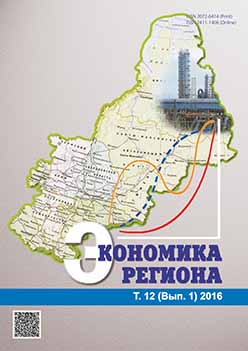Изучение эколого-экономических показателей посредством новой версии интегрированной модели MERGE. Часть 2
Study of the Eco-Economic Indicators by Means of the New Version of the Merge Integrated Model
Part 2
Author(s): Boris Vadimovich Digas, Valeriy Lvovich Rozenberg, Anastasiya Igorevna BoyarskikhSubject(s): Economy
Published by: Институт экономики Уральского отделения Российской академии наук
Keywords: complex estimated models; intertemporal optimization; scenarios of economic development; emission of greenhouse gasses; green gross domestic product;
Summary/Abstract: One of the most relevant issues of the day is the forecasting problem of climatic changes and mitigation of their consequences.The official point of view reflected in the Climate doctrine of the Russian Federation consists in the recognition of the need of thedevelopment of the state approach to the climatic problems and related issues on the basis of the comprehensive scientific analysisof ecological, economic and social factors. For this purpose, the integrated estimation models of interdisciplinary character areattracted. Their functionality is characterized by the possibility of construction and testing of various dynamic scenarios ofcomplex systems. The main purposes of the computing experiments described in the article are a review of the consequences ofhypothetical participation of Russia in initiatives for greenhouse gas reduction as the Kyoto Protocol and approbation of oneof the calculation methods of the green gross domestic product representing the efficiency of environmental management inthe modelling. To implement the given goals, the MERGE optimization model is used, its classical version is intended for thequantitative estimation of the application results of nature protection strategies. The components of the model are the eco-powermodule, climatic module and the module of loss estimates. In the work, the main attention is paid to the adaptation of theMERGE model to a current state of the world economy in the conditions of a complicated geopolitical situation and introductionof a new component to the model, realizing a simplified method for calculation the green gross domestic product. The Project ofscenario conditions and the key macroeconomic forecast parameters of the socio-economic development of Russia for 2016 andthe schedule date of 2017−2018 made by the Ministry of Economic Development of the Russian Federation are used as a basicsource of entrance data for the analysis of possible trajectories of the economic development of Russia and the indicators of theirecological efficiency. Calculations show that Russia has reserves allowing its participation in the nature protection initiativesconsisting in the non-exceedance of the emissions levels of 1990 by 2020−2025. At the same time, a goal of increasing theecological efficiency of the Russian gross domestic product is relevant and demands to address this matter urgently. We supposethat modelling results may be in demand by the competent bodies taking managerial decisions.
Journal: Экономика региона
- Issue Year: 12/2016
- Issue No: 1
- Page Range: 251-256
- Page Count: 6
- Language: Russian

